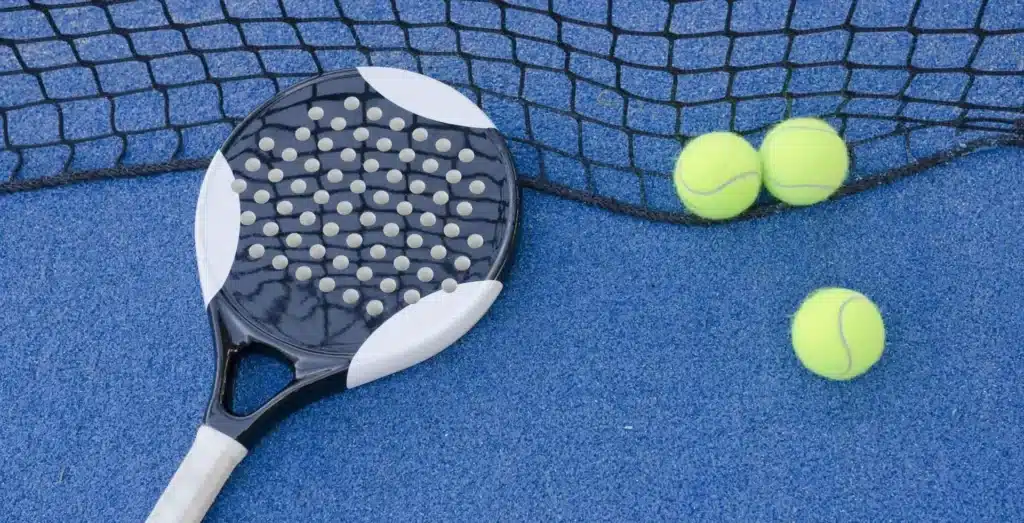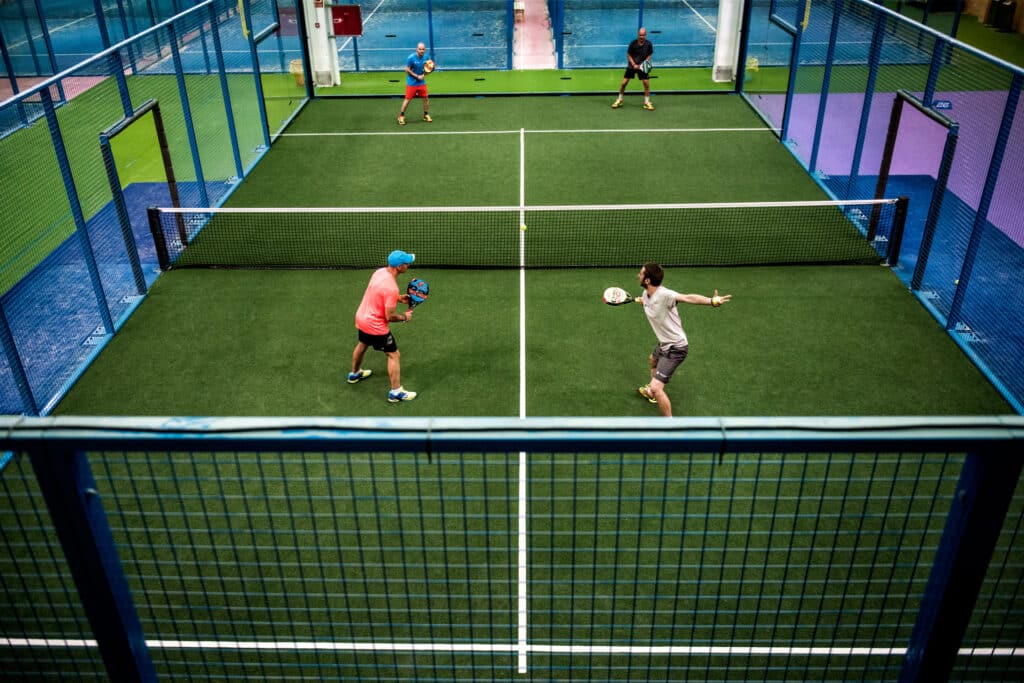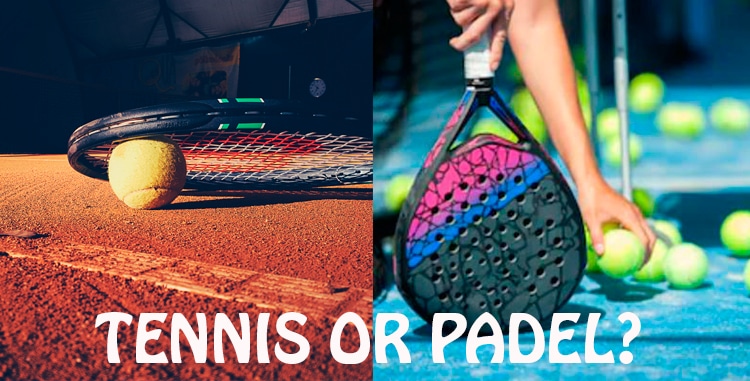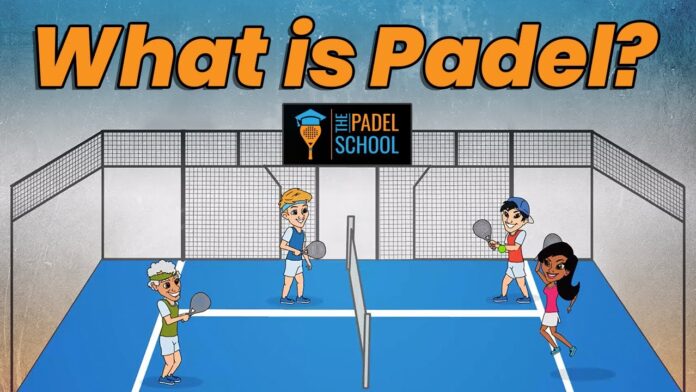In the world of racquet sports, where agility meets strategy and finesse blends with athleticism, one game stands out for its unique charm and growing popularity: Paddle Tennis.
This exhilarating sport has taken the sporting community by storm, attracting players of all ages and skill levels with its blend of classic tennis and platform tennis elements.
Originating in the early 20th century, paddle tennis has evolved into a thrilling and dynamic game that captures the essence of both traditional tennis and its winter counterpart, platform tennis.
Throughout the years, paddle tennis has proven to be much more than just a pastime; it has become a social and competitive pursuit, fostering a vibrant and enthusiastic community of players around the globe.

From neighbourhood courts to professional competitions, the echoes of the paddles hitting the ball resonate with an unparalleled sense of camaraderie and joy. In this article, we delve into the world of paddle tennis, exploring its history, rules, and unique gameplay that distinguishes it from its racquet sports cousins.
Whether you’re a seasoned athlete seeking a new challenge or a curious enthusiast eager to discover this captivating sport, join us as we embark on a journey to understand and appreciate the art of paddle tennis, where elegance and fervour unite on the court.
Read Also: How Many Games Are in NBA Season?
What is Paddle Tennis?
Paddle tennis is a racquet sport combining traditional and platform tennis elements, played on a smaller court with solid paddles and a depressurized tennis ball. The game is often referred to as “Paddle” for short.
While it shares similarities with both tennis and platform tennis, it possesses its own unique set of rules and style of play, making it a distinct and engaging sport in its own right.
Origins
The roots of paddle tennis can be traced back to the early 20th century. The sport’s exact origins are somewhat disputed, with multiple accounts suggesting different beginnings. One commonly accepted narrative is that paddle tennis was first played in the United States in the early 1920s.
It is believed to have emerged as a winter alternative to traditional tennis, allowing enthusiasts to continue playing even during colder months. The game’s early adopters were looking for a way to enjoy tennis year-round without the need for larger indoor facilities.
They adapted the game to smaller courts and utilized solid paddles to cope with the winter conditions. The sport gained popularity rapidly, particularly in regions with colder climates, as it provided a thrilling outdoor activity that was well-suited for the winter season.

Over time, paddle tennis evolved, incorporating elements from both tennis and platform tennis. Its distinctive characteristics include the use of wooden or composite paddles, a lower net, a smaller court, and a unique scoring system. These features combined to create a game that offered fast-paced action and an emphasis on quick reflexes and precise shots.
Today, paddle tennis has grown beyond its winter roots and is enjoyed throughout the year in various regions across the world. Its appeal lies in the perfect balance it strikes between skill and strategy, making it an accessible and engaging sport for players of all ages and skill levels.
As paddle tennis continues to gain traction and attract new enthusiasts, its evolution as a dynamic and captivating sport remains a testament to the enduring legacy of those early pioneers who sought to create a thrilling game that embraced the best of tennis and platform tennis.
Read Also: Sports Betting in Nigeria
The Rules of Paddle Tennis
Paddle tennis is a racquet sport that combines elements of tennis and platform tennis. While the rules may vary slightly depending on the location and level of play, the fundamental principles remain consistent. Here are the standard rules of paddle tennis:
1. Court and Equipment:
- The game is played on a court with dimensions of 20 feet wide by 44 feet long, which is about a third of the size of a traditional tennis court.
- The court is enclosed by a screen or fence that prevents the ball from leaving the playing area.
- Paddle tennis is played with solid paddles made of wood or composite materials and a depressurized tennis ball, which is less bouncy compared to regular tennis balls.
2. Scoring:
- Paddle Tennis uses a modified scoring system similar to tennis. The game is typically played in sets, with the first player or team to win six games (by a margin of two) winning the set.
- If the score is tied at 5-5, a tiebreaker game is played to determine the winner of the set. The tiebreaker game is played to seven points, and the player or team must win by two points.
3. Service:
- The serve is underhanded, and the server must stand behind the baseline while serving.
- The ball must be struck with the paddle below waist level and bounce within the opponent’s service court diagonally, as in tennis.
- Unlike in tennis, there are no second serves; if the first serve is faulted (e.g. if the ball doesn’t land in the correct service area), the server loses the point.
4. Rally and Gameplay:
- The rally begins after the serve, and the ball must bounce once on each side of the net before players can hit it on the fly (volley).
- Players can use the walls of the court to keep the ball in play, similar to platform tennis, adding an extra tactical dimension to the game.
- The objective is to outmanoeuvre oopponents by hitting the ball past them or forcing them to make errors.
5. Scoring Points:
- Points are scored when the opponent fails to return the ball within the boundaries of the court, hits the ball out of bounds, or commits a fault.
- A fault occurs when a player misses the ball while trying to hit it, hits the ball into the net on the serve, or violates any other specific rule.
6. Let Rule:
- If the ball hits the net on the serve and lands in the proper service area, it is called a “let,” and the server gets to re-serve without penalty.
Remember that while these are the standard rules, variations may exist in different regions or levels of play. It’s always essential to confirm the specific rules being used in a particular match or tournament.
With its fast-paced action and exciting gameplay, paddle tennis continues to captivate players and spectators alike, fostering a strong sense of community and camaraderie on and off the court.
Paddle Tennis Equipment
Paddle tennis requires specific equipment tailored to the unique characteristics of the sport. From paddles to balls and appropriate attire, having the right gear ensures a safe and enjoyable playing experience. Here are the essential items used in Paddle Tennis:
1. Paddles:
- Paddles are the primary equipment used in Paddle Tennis, and they come in various shapes, sizes, and materials.
- Paddle tennis paddles are typically smaller and more solid than traditional tennis rackets. They are designed to provide players with better control and manoeuvrability on the smaller court.
- The paddles’ composition can vary, with most being made of wood or composite materials like graphite or carbon fibre. Each material offers different levels of power and touch, allowing players to choose paddles that suit their playing style.
2. Balls:
- Paddle tennis balls are specialized for the sport and differ from standard tennis balls.
- The balls used in Paddle tennis are depressurized, which means they have lower internal pressure. This results in reduced bounce, making the game more manageable on the smaller court.
- The lower bounce allows players to maintain longer rallies and employ strategic wall shots to keep the ball in play.
3. Court:
- The Paddle tennis court is smaller than a traditional tennis court, with dimensions of 20 feet wide by 44 feet long. A screen or fence encloses the court to keep the ball from leaving the playing area.
- Some courts have an artificial turf surface, while others may have a textured concrete or hard surface.
4. Attire:
- Players typically wear athletic clothing suitable for outdoor or indoor play, depending on the venue.
- Proper sports shoes with non-marking soles are essential to ensure good traction on the court and prevent damage to the playing surface.
5. Protective Eyewear:
- Although not always mandatory, some players opt to wear protective eyewear to shield their eyes from stray balls or accidental paddle contact during play.
6. Grip Enhancers:
- Some players use grip enhancers like grip tapes or overgrips to improve their handling and control of the paddle.
7. Court Accessories:
- In some cases, Paddle Tennis courts may have additional accessories like windscreens to reduce wind interference during play or heating elements to keep the court surface dry and playable in cold weather.
Paddle Tennis equipment is generally readily available at sporting goods stores, online retailers, or specialty Paddle Tennis shops. When selecting paddles and other gear, it’s essential to consider factors such as weight, grip size, and material to match individual preferences and playing styles.
See Also: 4 Ex NBA Players Who Are Jehovah’s Witnesses
Health Benefits of Paddle Tennis
Paddle Tennis is not just a fun and social sport; it also offers numerous health benefits for players of all ages and skill levels. Engaging in regular Paddle Tennis sessions can have positive effects on both physical and mental well-being. Here are some of the notable health benefits of playing Paddle Tennis:
1. Cardiovascular Fitness:
- Paddle Tennis is an excellent cardiovascular workout, as it involves continuous movement, running, and quick direction changes. The combination of short bursts of high-intensity movements and active recovery periods helps improve heart health and stamina.
2. Full-Body Workout:
- Paddle Tennis engages various muscle groups in the body, including the legs, core, arms, and shoulders. Players utilize these muscle groups to run, swing the paddle, and hit the ball, resulting in a comprehensive full-body workout.
3. Improved Reflexes and Coordination:
- The fast-paced nature of Paddle Tennis necessitates quick reactions and hand-eye coordination. Regular play can enhance reflexes and fine-tune motor skills, which can be beneficial in everyday activities and other sports.
4. Weight Management:
- Paddle Tennis is an effective calorie-burning activity that can aid in weight management and weight loss efforts. Playing regularly can help individuals maintain a healthy body weight.
5. Joint and Bone Health:
- The low-impact nature of Paddle Tennis makes it easier on the joints compared to higher-impact sports like running. This reduces the risk of joint strain and injury, making it an accessible sport for individuals of various fitness levels.
6. Stress Reduction:
- Like any physical activity, Paddle Tennis triggers the release of endorphins, the “feel-good” hormones. These hormones can help reduce stress, anxiety, and depression, promoting a positive mood and mental well-being.
7. Social Interaction:
- It is often played in doubles or mixed doubles, fostering social interaction and teamwork among players. The sense of camaraderie and the opportunity to make new friends can contribute to overall happiness and mental health.
8. Balance and Agility:
- The need to react quickly and change direction during a game enhances balance, agility, and overall body control. These skills are valuable in everyday life, reducing the risk of falls and injuries.
9. Cognitive Benefits:
- It requires strategic thinking and decision-making during gameplay. Engaging in this mentally stimulating sport can help improve cognitive abilities, memory, and problem-solving skills.
10. Longevity:
- Regular physical activity, such as playing Paddle Tennis, is associated with a reduced risk of chronic health conditions and increased longevity, contributing to an overall healthier and more active lifestyle.
As with any sport or physical activity, it’s essential to warm up before playing Paddle Tennis and to practice proper technique to minimize the risk of injury. Whether played competitively or recreationally, It offers a fun and effective way to improve fitness, maintain a healthy lifestyle, and enjoy many physical and mental health.
How to Get Started with Paddle Tennis
Getting started with Paddle Tennis is an exciting journey that opens the door to a fun and engaging sport. Whether you’re a beginner or an experienced player looking to try something new, here’s a step-by-step guide to help you get started with this Tennis:
1. Find a Court:
- Look for Paddle Tennis courts in your local area. You can search online or inquire about sports clubs, community centres, or recreational facilities. Some tennis courts may also have Paddle Tennis lines, allowing you to play on a dual-purpose court.
2. Gather Equipment:
- Before heading to the court, make sure you have the necessary equipment. If you’re just starting, consider borrowing a paddle from a friend or renting one from the court facility. As you progress, you can invest in your paddle and proper Paddle Tennis balls.
3. Learn the Basics:
- Familiarize yourself with the rules and basic techniques of this Tennis. You can find instructional videos online or take a lesson from a qualified Paddle Tennis instructor. Learning the fundamentals will help you feel more confident on the court and make the experience more enjoyable.
4. Play with Beginners:
- Seek out other beginners or players of a similar skill level to practice with. Playing with others who are also learning allows you to develop your skills together and creates a supportive and comfortable environment.
5. Join a Club or Group:
- Many areas have Paddle Tennis clubs or social groups where players of all levels come together to play and have fun. Joining such a club can introduce you to the Paddle Tennis community and provide opportunities to play regularly with different people.
6. Participate in Social Events and Tournaments:
- Once you’re comfortable with the game, consider participating in social events or local Paddle Tennis tournaments. These events allow you to compete and challenge yourself and offer a chance to meet other players and make new friends.
7. Take It Slow and Have Fun:
- Remember that Paddle Tennis, like any sport, takes time and practice to improve. Don’t be discouraged by initial challenges; instead, focus on enjoying the process and having fun on the court.
8. Stay Safe and Hydrated:
- Always warm up before playing to prevent injuries, and stay hydrated during play, especially in warmer weather. Paddle Tennis can be physically demanding, so taking care of your body is essential.
9. Embrace Continuous Learning:
- It offers numerous opportunities for skill development and growth. Be open to learning from experienced players, watching matches, and trying out different techniques to enhance your game.
Remember, the key to getting started with this Tennis is to jump in and give it a try. The more you play, the more you’ll discover the enjoyment and excitement this dynamic sport has to offer. So, grab your paddle, head to the court, and embark on your Paddle Tennis journey today!
See Also: Google Doodle Baseball: All You Need to Know About The Sport
Paddle Tennis Community and Events
Paddle Tennis has a vibrant and welcoming community that continues to grow in popularity across various regions. The sport’s unique blend of competitiveness and social interaction fosters a sense of camaraderie among players of all skill levels. Here’s a glimpse into the Paddle Tennis community and the events that bring enthusiasts together:
1. Local Clubs and Social Groups:
- Paddle Tennis clubs and social groups are a hub for players to connect and enjoy the sport together. These clubs often organize regular playing sessions, offer coaching programs, and host social events, creating a sense of belonging and camaraderie among members.
2. Tournaments and Leagues:
- Paddle Tennis tournaments and leagues provide players with competitive opportunities at various levels. Local, regional, and national tournaments are held throughout the year, allowing players to showcase their skills and compete against others with similar abilities.
3. Charity and Fundraising Events:
- Many of these events are organized for charitable purposes, raising funds for community causes, health research, or other charitable organizations. These events combine sportsmanship with giving back, creating a positive impact beyond the court.
4. Exhibition Matches and Pro-Ams:
- Exhibition matches and Pro-Am events feature professional players and top-level amateurs playing together in an entertaining format. These events offer a chance for amateur players to play alongside and learn from seasoned professionals.
5. Clinics and Workshops:
- Experienced players and coaches conduct Paddle Tennis clinics and workshops to help participants improve their skills. These sessions focus on various aspects of the game, including technique, strategy, and match play.
6. Paddle Tennis Social Media and Online Communities:
- Online platforms, such as social media groups and forums, bring Paddle Tennis enthusiasts together worldwide. Players share tips, experiences, and updates on upcoming events, fostering a global Paddle Tennis community.
7. Paddle Tennis Festivals:
- Paddle Tennis festivals are special events that celebrate the sport, featuring a combination of competitive matches, exhibition games, social activities, and entertainment. These gatherings attract players and fans alike, creating a festive atmosphere.
8. Paddle Tennis Exhibitions at Sporting Events:
- Their exhibitions may take place during larger sporting events or as part of community festivals. These exhibitions introduce the sport to a broader audience and showcase its excitement and athleticism.
9. Paddle Tennis Online Streaming and Broadcasting:
- With the growing interest in Paddle Tennis, some major events are streamed online or broadcasted on television, allowing fans to follow their favourite players and matches.
The Paddle Tennis community is known for its welcoming spirit, where players of all backgrounds and skill levels are encouraged to participate and grow. Whether you’re a casual player looking for social play or a dedicated competitor seeking challenging tournaments, the Tennis community offers something for everyone.
Read Also: What are the 6 NBA Divisions
Paddle Tennis vs Padel
Paddle Tennis and Padel are two distinct racquet sports that are sometimes confused due to their similar names. While they share some similarities, they have significant differences in terms of rules, equipment, and court dimensions. Here’s a comparison between the two:

1. Origins:
- Paddle Tennis originated in the early 20th century in the United States as a winter alternative to traditional tennis.
- Padel: Padel, also known as padel tennis, originated in Mexico in the late 1960s and gained popularity in Spain and other Spanish-speaking countries.
2. Court Size:
- Paddle Tennis: It is played on a smaller court compared to traditional tennis, with dimensions of 20 feet wide by 44 feet long.
- Padel: Padel is played on a significantly smaller court than Paddle Tennis and traditional tennis, with dimensions 20 meters wide by 10 meters long.
3. Court Surface:
- Paddle Tennis: Their courts can have various surfaces, such as artificial turf, textured concrete, or hard surfaces.
- Padel: Padel courts typically have a synthetic or artificial grass surface, similar to some artificial turf types.
4. Equipment:
- Paddle Tennis: It is played with solid paddles made of wood or composite materials and a depressurized tennis ball.
- Padel: Padel is played with solid paddles, similar to Paddle Tennis, but the balls used in Padel are punctured with holes, similar to those used in platform tennis. The balls are pressurized, providing more bounce compared to Paddle Tennis balls.
5. Scoring:
- Paddle Tennis: It uses a modified scoring system similar to traditional tennis, with sets won by the first player or team to reach six games, often using a tiebreaker if the score is tied at 5-5.
- Padel: Padel uses a unique scoring system where points are counted in a sequence: 15, 30, 40, and game. Additionally, the first team to win six games (by a margin of two) wins the set.
6. Play:
- Paddle Tennis involves hitting the ball over the net and bouncing it once on each side before allowing volleys.
- Padel: Padel allows the ball to bounce off the surrounding walls, similar to squash, making it a more tactical and strategic game with less reliance on power shots.
While both sports share elements of tennis and have their own appeal, this Tennis and Padel have distinct characteristics and are enjoyed by players with different preferences. Both offer engaging gameplay and foster vibrant communities of players passionate about racquet sports.
Paddle Tennis is a dynamic and captivating racquet sport that combines traditional tennis’s elegance with platform tennis’s strategic intensity. From its humble origins as a winter alternative to tennis, this exciting game has evolved into a sport cherished by players of all ages and skill levels worldwide.
With its smaller court, solid paddles, and depressurized balls, it offers a unique and accessible playing experience that caters to both seasoned athletes and newcomers alike. The sport’s fast-paced action, emphasis on quick reflexes, and creative use of the court walls make it an exhilarating and engaging game that leaves players enthralled.
See Also: The NFL Mock Draft: A Complete Analysis
Beyond the physical benefits of improved cardiovascular fitness, agility, and coordination, it nurtures a sense of community and camaraderie among its players. Whether on local courts, in clubs, or during tournaments and events, the sport brings together individuals who share a passion for competition, sportsmanship, and the joy of the game.
FAQs for Paddle Tennis
Is Padel Tennis easier than tennis?
It is easier to play and learn than tennis because less physical strength and technical capacities are demanded. There is a fantastic combination between your brain, challenged to its limits, and your body that has to move a lot, but not necessarily as accurately as in tennis.
What is the difference between paddle tennis and tennis?
The paddle tennis court is smaller (44 feet long and 20 feet wide with a playing area of 60 feet by 30 feet) than a typical tennis court surrounded by a tightly strung wired fence (12 feet high) which comes into play after the ball bounces off the court.
What is paddle tennis also known as?
It, also known as Padel or Paddle, originates from a not-so-popular variant of enclosed Tennis called Platform Tennis.
Why is it called Padel?
In 1993, the Sports Council of Spain recognised paddle as a sport and changed its spelling to padel for pronunciation purposes in the Spanish language. In 2005 the first professional world tour, Padel Pro Tour, was created.
How many countries play Padel?
Padel is played in more than 90 countries around the world. This naturally means that there are also padel courts in more than 90 countries.





